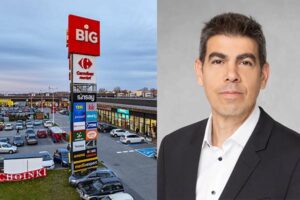The world of retail real estate has faced a host of challenges over the past 15 years and continues to do so. From financial market crises and increasing online market shares to lockdowns imposed during the coronavirus pandemic – the “catalog” is wide-ranging. The industry, however, has always adapted, learned valuable lessons, and moved on to the “next round” stronger than ever. The determining factor behind the long-term success of a location, as has been shown, is not the capital with which a location is built and operated, but the customers who generate sales at the retail location. As banal as that may sound, the “question of existence” vis-à-vis the customer is one that many retail locations are currently grappling with in earnest, explains Reinhard Winiwarter, Founder and Managing Director of ACROSS, in his 15-year retrospective.
I was fortunate enough to have entered the retail real estate scene as early as 1996 and to have experienced it from a number of different perspectives: as a center manager, as a marketing specialist, as a consultant, and as a publisher. I personally consider the thematic areas mentioned herein to be the most influential ones of the last 15 years:
1. Tremendous Increase in Complexity
When comparing the overall stakeholder environment of a retail site in 2008 with that of 2023, one thing becomes immediately clear: The complexity of all components within the industry has increased dramatically. In 2008, retail sites had clear business models, which seem simple from today’s perspective, and the leasing business was at the core. There was a developer, who determined the site concept, the architecture, and the the shop mix, which basically consisted of food, beauty, fashion, hardware, gastronomy, and a few services. Customers bought what they saw.
The business model of a given center in 2023 can be described as complex location optimization. Raising capital has become more complex and there are a number of different stakeholders to simultaneously satisfy. Centers of 2023 have had to come to grips with how dependent they are on external factors, such as omnichannel, e-commerce, ESG, and sustainability, and how vulnerable they are to unpredictable shocks such as the COVID-19 pandemic. The business model has become highly complex and fragile: What we are talking about is mixed use and integration into the immediate surroundings on the one hand, and the metaverse on the other. The “reigning knowledge” of the retail real estate product has migrated from the developer and management to the customer. However, the increase in complexity has also led to the entire business environment becoming more diverse, more creative, and perhaps also more intelligent.
2. Individuality Trumps Standard Concepts
There was a time when operators were convinced that a successful concept could be duplicated at any location – the same architectural concept, the same shop mix, and the same marketing concept. Those days are long gone. The yardstick for the success of a retail location is the optimal adaptation of the offer to the respective catchment area. Two things are required to that end: 1) to really engage with a catchment area and 2) to consistently think outside of the (retail) box. Many mixed-use approaches stem from those exact considerations. What is required in the catchment area? In 2023, that may very well be a local childcare center, which would appear to make sense if done in cooperation with the municipality. In the meantime, the financial sector has also learned that the “pure-use” approach may offer advantages from a financial point of view, but that the customer, who ultimately determines the long-term survival of a location, is utterly indifferent to it.
3. Customers Determine Long-term Success, Not Capital
While a lot has changed in 15 years, the basic maxim has not. The history of retail real estate began with merchants who joined forces to develop a new retail form. The success of the new type of retail operation attracted the financial sector. Over the years, the shopping center became a financial market product, thereby rendering money, instead of the customer, the driver. In 2023, the placemaking industry is, without a doubt, both complex and challenging. When capital is scarce, it is all the more important to return to the true driver of the business model: the consumer. The customer must become the linchpin of the industry once again.
4. Center Openings
It is a modern-day trend: Centers are successful if they are open. A number of shopping centers were designed in such a way that they both guided customers through enclosed buildings and “kept” them inside. Nowadays, customers want to decide for themselves whether to remain “inside” or “outside”. Furthermore, a shopping center must interact with its environment – it must be part of a given community. That marks a major difference in thinking. Digitalization is an equally important megatopic that must be considered when it comes to center openings. Turning centers into retail hubs is the greatest present-day challenge. For retailers, that involves the constant testing of new omnichannel approaches. Operationally, investment in more efficient processes is essential. For example, a center that does not offer pick-up stations for delivery services that are externally accessible will be virtually incapable of attracting modern gastronomy concepts as tenants.
5. The Lines between the “Asset Classes” are Blurring
While they still remained the inconspicuous stepchildren of the industry in 2008, retail parks have likely experienced the most impressive growth over the past 15 years. In 2023, they are more successful than many shopping centers. Retail parks used to be traditional out-of-town assets designed to serve customers in a quick and easy manner. The attributes of easy accessibility and targeted shopping are ideally suited to the expectations of today’s customers. However, if customers expect more than just the supply of goods, their demands will also be greater. As far as retailers and shopping center managers are concerned, not only do they have to win the battle for customers, they also have to win it well. In the past, the shopping center was the “most modern place” in a city. That leadership role has gone by the wayside, and the last three years of COVID-19 have clearly shown that many operators have spent far too much time resting on their laurels. There are numerous center locations that have a lot of catching up to do.
6. The Strengths of the Past are the Strengths of the Future
There are the two well-known phrases: “retail equals change” and “change is the only constant”; both fit the placemaking industry to a tee and aptly characterize the past, eventful 15 years. Nevertheless, the retail real estate sector’s very own strength has remained a constant. The sector’s projects face the challenges of the times and overcome them by means of well-thought-out, experienced, and strong organizational structures. That proved to be its strength in the past, and it will continue to be so in the future – as long as it succeeds in inspiring the professionally and personally committed and capable people who are needed to meet all of the associated challenges. At the end of the day, retail business is people business. I, for one, am looking forward to the next 15 years; it would be my absolute pleasure to continue to accompany you on this journey with ACROSS.







